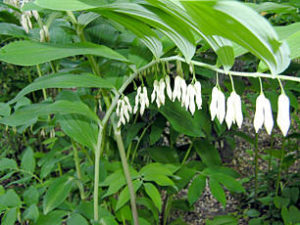 |
| Solomon’s seal is one of dozens of flowering plants that support the ruby-throated hummingbird. English photo. |
by Deb Soule
Hummingbirds of North America, by Sheri Williams, lists 31 species of hummingbirds, but the ruby-throated hummingbird (Archilochus colubris) is the only breeding hummingbird living east of the Mississippi River. It is found in Maine between May and September.
Hummingbirds are primarily tropical birds. They began to expand their ranges northward in search of rich temperate food sources and nesting spaces after the last Ice Age. Because hummingbirds rely on nectar to fuel their flycatching activity, and neither nectar nor insects are available during our winters, the ruby-throated hummingbird must return to Central America each fall. Males leave first; then females, usually by the middle of September. Most ruby-throated hummingbirds winter between southern Mexico and northern Panama.
Spiders and tiny insects such as flies, gnats and aphids are the main sources of fat and protein for hummingbirds. These foods help the tiny, 3 1/2-inch-long ruby-throated hummingbird to increase its weight from about 3.25 to 6 grams before crossing the Gulf of Mexico. A single migration can become a nonstop flight of up to 500 miles over 18 to 22 hours.
Ruby-throated hummingbirds that are too old, sick or young to store enough fat to migrate across the Gulf will winter along the Gulf Coast of the United States, and their rate of survival depends on the severity of the winter. Another small population of ruby-throated hummingbirds winters in the Outer Banks of North Carolina.
Ruby-throats begin moving north in January and by late February are at the northern coast of Yucatan, devouring insects and spiders to prepare for their flight back across the Gulf of Mexico. The males leave the Yucatan first; females follow 10 days later. Hummingbirds are solitary birds, each with its own internal map and schedule for departure and arrival.
Once in North America, ruby-throats migrate an average of 20 miles per day, following the earliest blooming of their preferred flowers. The northward migration is complete by late May, and banding studies show that each bird tends to return every year to the same place it hatched. The northern limit for ruby-throats is the same as that of the yellow-bellied sapsucker.
| THE REBECCA WILLOW HERBAL APPRENTICESHIP FUND
In 1986, at age 15, Rebecca Willow found her way to herbalist and gardener Deb Soule and became Deb’s first apprentice. Rebecca grew up gardening organically and being home-schooled in Montville, Maine, by her parents, Bruce and Bea, who supported her interest in medicinal herbs. Rebecca spent a few summers working alongside Deb in Avena Botanicals’ medicinal herb gardens as an apprentice. Rebecca followed her passion for herbs, and, after graduating from Marlboro College, moved to New Mexico and attended a three-year medical herbalist program. Upon completion, she returned to the Brattleboro, Vermont, area, where she opened her own private practice and created a lovely line of teas and skin care products. In June of 2006, Rebecca was diagnosed with an unusual type of cancer. To honor and keep alive Rebecca’s spirit and passion for medicinal plants, her husband and Deb have established The Rebecca Willow Herbal Apprenticeship Fund, which will allow a young woman each year to spend three to six months living and working alongside Deb in West Rockport, Maine. Donations can be sent to The Rebecca Willow Fund, c/o Deb Soule, 219 Mill St. Rockport, ME 04856. An apprenticeship application is available from the same address. |
For years I have been carefully observing which medicinal herbs and flowers hummingbirds visit frequently in Avena Botanicals’ gardens. Instead of putting out a feeder of sugar water, consider adding some of the following flowers, trees and medicinal herbs to your garden. I plant windowboxes with fuchsias and enjoy standing at my kitchen sink and watching hummingbirds feed just inches away.
- Apple (Malus spp.)
- Bee balm (Monarda didyma, and M. fistulosa)
- Blazing star (Liatris spp.)
- Butterfly bush (Buddleia spp.)
- Cardinal flower (Lobelia cardinalis)
- Clary sage (Salvia sclarea)
- Columbine, wild (Aquilegia canadensis)
- Coral bells (Heuchera sanguinea)
- Dandelion (Taraxacum officinale)
- Evening primrose (Oenothera biennis)
- Fuchsia (Fuchsia spp.)
- Grecian foxglove (Digitalis lanata)
- Honeysuckle (Lonicera spp., but not the invasive Japanese honeysuckle, L. japonica)
- Hummingbird sage (Salvia coccinea)
- Jewelweed (Impatiens capensis)
- Lily (Lilium spp.)
- Lungwort (Pulmonaria officinale)
- Marshmallow (Althea officinalis)
- Mexican sunflower (Tithonia spp.)
- Nasturtium (Tropaeolum majus)
- Nicotiana, jasmine scented (Nicotiana alata)
- Quince, flowering (Chaenomeles japonica)
- Solomon’s seal, true (Polyganatum spp.)
About the author: Deb is the founder of Avena Botanicals and the Avena Institute in West Rockport, Maine, and author of A Woman’s Book of Herbs. You can visit her Web site at www.avenaherbs.com.

